Beckley, Oxfordshire (†Oxford) C.14
Virgin Suckling the Child, with other details
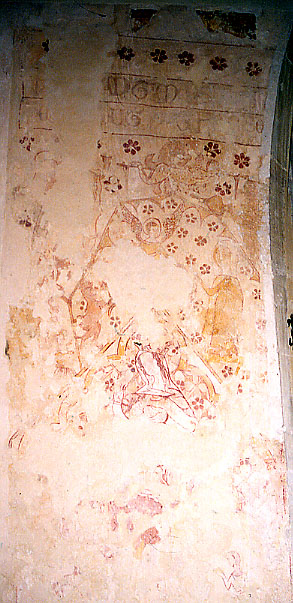
Although some straightforward paintings of the Virgin and Child still remain in English churches, the Virgin actually suckling the Christ Child is very uncommon and only a few others are left. Two are now on the site, however, at Faversham and Belchamp Walter respectively. Another at Great Canfield in Essex is still to come. Eve, in a scene of Adam Delving and Eve Spinning, might also be suckling a baby at Bledlow. This painting of Eve doing so, painted on a pier in the south aisle Lady chapel, is surrounded by some odd details – odd on the face of it, but explicable, I think.
Below is the enlarged central detail; the Virgin, crowned, and with her hair loose, with her left hand presents her pear-shaped breast to the Child. Her right hand is raised, not, I suspect, in a gesture of blessing, but indicating what is going on above. The very elaborate frame, enclosing a highly decorative rose and trellis background, shows well here, but I can see nothing now of the kneeling figure ‘almost entirely defaced’¹, that Tristram detected below at the left – a tiny figure, right hand raised, at the lower right (main picture, left above) is commented on and shown enlarged at the bottom of this page.
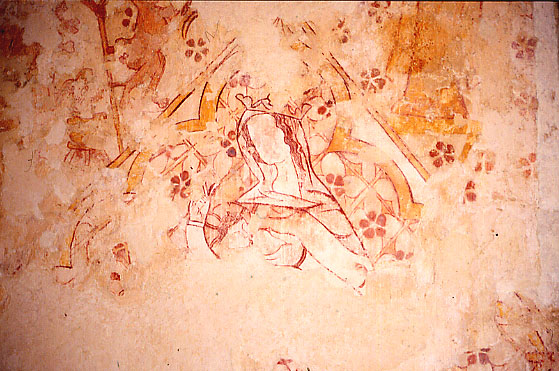
Above the Virgin and Child, and in a cusped, many-sided frame of their own, are more details concerned with Judgement and damnation (detail, below right).
Directly above the crowned, breastfeeding Virgin is an angel, extending his left arm towards a kneeling(?) female figure in robe, cloak and headdress. The angel is Michael (not in armour at this relatively early date). The woman is the Virgin Mary again, presented here with no visible halo as a smiling, matronly presence – and this is the point, I think. This is another Weighing addditional to that associated with the Doom, and it depicts an individual newly-dead soul whose in-life devotion to the Virgin has moved her to intervene on its behalf by dangling her rosary into the scale-pan as at Slapton and Lathbury.
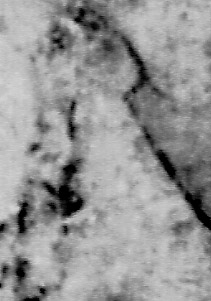
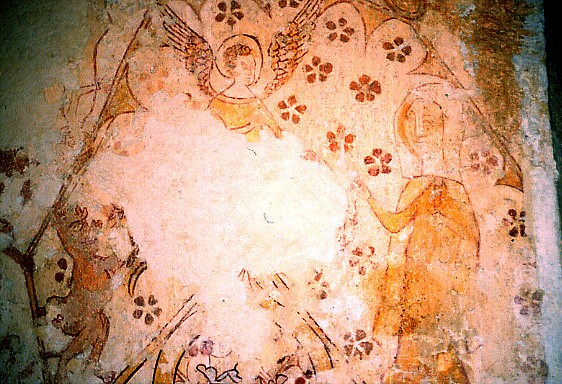
The devilish, grinning creature on the left is trying to prevent this by hauling on the other scale-pan. The scale-pan itself has gone – gone in what may have been a deliberate act of 15th century Iconoclasm, as one commentator called it. Whoever defaced this part (and, I suspect, only this part – the unpigmented areas below do not look like the result of deliberate damage) of the painting seems to have been exclusively concerned to obscure the apparatus for the weighing of an individual soul, presumably on theological grounds too complex for discussion here.* Beside this devil, but outside the frame and visible in the previous photograph, is an obscure figure on a three-legged stool, or, perhaps more likely, in a pot placed over a fire. This would no doubt have been the next stage in the journey for the weighed soul, had the devils, and not the Virgin prevailed, and the details further above, outside the frame, seem to support this. So the Virgin Mary at Beckley is invoked as both ‘Moder and virgine’ as in the contemporary poem quoted in the Introduction to this subject, and in this almost-obliterated Weighing her specific ‘medicine’ is successfully invoked by the dead soul.
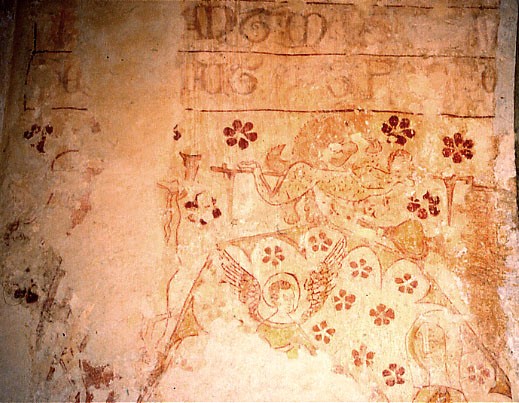
At the top of the painting, hellish activities are going on. Above the angel, but again outside the frame, a figure roasts impaled on a crude spit made of forked sticks and a crosspiece with a turning-handle. Below this handle, at the extreme right, a very obscure figure operates a pair of bellows, fanning the flames underneath the spit. This is the only example of this particular detail I know of in England, but there is another in France, at Sillegny, near Metz, where it is part of a Doom (Jugement Dernier). To the left, another figure hangs by his heels from a hook, perhaps awaiting the same fate. A third devilish figure, described by ET Long as ‘half-man, half-beast’² and distinguished by a fat tail like a fox’s brush, stands in a crouching posture behind the spit. Long is probably right to suggest that this figure is pouring something – the obvious substance would be oil – over the man being roasted. Although it might explain much, neither Long nor Tristram could read the upper-case inscription above, and neither can I, although I wonder if the final word might be some form of sperare, to hope (for).
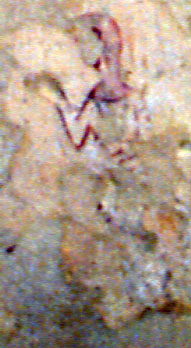
Finally, here at the right is a tiny figure described in the excellent illustrated church booklet as probably a moquette or two-dimensional lay-figure worked by the master painter for an apprentice to reproduce elsewhere on the wall. It is close enough in outline to the matronly, ‘mother-figure’ Virgin above to make this highly probable: clearly a far less competent hand produced the ill-proportioned end result.
To see the entire painted area of the Lady Chapel wall follow this link. Even the tiny moquette figure shows on this page at the bottom right.
There are still more paintings at Beckley, on the west wall. Most of these are post-medieval, but in general terms the entire iconography of Beckley – including its glass and brass monuments – may turn out to be very important for the understanding of Marian devotion and of medieval theology generally. The work goes on.
Website for Church of the Assumption, Beckley
¹ Tristram III, p.139
² ET Long, Medieval Wall Paintings in Oxfordshire Churches, Oxfordshireiensia, Vol. XXXVII, 1972, p. 91
*But for the benefit of anyone else intrigued, I am thinking of Christian Mortalism and associated ‘heresies’